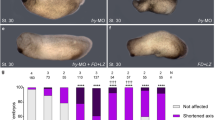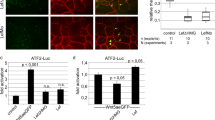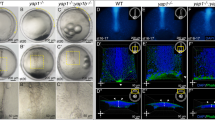Abstract
Gastrulation movements are critical for establishing the three germ layers and the architecture of vertebrate embryos. During Xenopus laevis gastrulation, mesodermal tissue migrates on the blastocoel roof and elongates along the antero-posterior axis1,2. During this process, cells in the dorsal mesoderm are polarized and intercalate with each other, which is defined as convergent extension and is known to be regulated by the non-canonical Wnt pathway3,4,5. Here, we show that paxillin plays an essential role in this process. Paxillin is a focal-adhesion associated protein implicated in the regulation of actin cytoskeletal organization and cell motility6,7, but its role in Xenopus embryogenesis has not yet been clarified. We demonstrate that the Wnt pathway controls the ubiquitination and stability of paxillin, and that this regulatory mechanism is essential for convergent extension movements. We identified a RING finger protein XRNF185, which physically binds to paxillin and the proteasome. XRNF185 destabilizes paxillin at focal adhesions and promotes mesodermal cell migration during convergent extension. We propose a mechanism to regulate gastrulation movements that involves paxillin ubiquitination and stability controlled by Wnt signalling.
This is a preview of subscription content, access via your institution
Access options
Subscribe to this journal
Receive 12 print issues and online access
$209.00 per year
only $17.42 per issue
Buy this article
- Purchase on Springer Link
- Instant access to full article PDF
Prices may be subject to local taxes which are calculated during checkout





Similar content being viewed by others
References
Wallingford, J. B., Fraser, S. E. & Harland, R. M. Convergent extension: the molecular control of polarized cell movement during embryonic development. Dev. Cell 2, 695–706 (2002).
Leptin, M. Gastrulation movements: the logic and the nuts and bolts. Dev. Cell 8, 305–320 (2005).
Heisenberg, C. P. et al. Silberblick/Wnt11 mediates convergent extension movements during zebrafish gastrulation. Nature 405, 76–81 (2000).
Smith, J. C., Conlon, F. L., Saka, Y. & Tada, M. Xwnt11 and the regulation of gastrulation in Xenopus. Philos. Trans. R. Soc. Lond. B Biol. Sci. 355, 923–930 (2000).
Wallingford, J. B. et al. Dishevelled controls cell polarity during Xenopus gastrulation. Nature 405, 81–85 (2000).
Turner, C. E. Paxillin and focal adhesion signalling. Nature Cell Biol. 2, E231–E236 (2000).
Carragher, N. O. & Frame, M. C. Focal adhesion and actin dynamics: a place where kinases and proteases meet to promote invasion. Trends Cell Biol. 14, 241–249 (2004).
Li, M. & Sakaguchi, D. S. Inhibition of integrin-mediated adhesion and signaling disrupts retinal development. Dev. Biol 275, 202–214 (2004).
Iioka, H., Ueno, N. & Kinoshita, N. Essential role of MARCKS in cortical actin dynamics during gastrulation movements. J. Cell Biol. 164, 169–174 (2004).
Critchley, D. R. Cytoskeletal proteins talin and vinculin in integrin-mediated adhesion. Biochem. Soc. Trans. 32, 831–836 (2004).
Ziegler, W. H., Liddington, R. C. & Critchley, D. R. The structure and regulation of vinculin. Trends Cell Biol. 16, 453–460 (2006).
Didier, C. et al. RNF5, a RING finger protein that regulates cell motility by targeting paxillin ubiquitination and altered localization. Mol. Cell Biol. 23, 5331–5345 (2003).
Tada, M. & Smith, J. C. Xwnt11 is a target of Xenopus Brachyury: regulation of gastrulation movements via Dishevelled, but not through the canonical Wnt pathway. Development 127, 2227–2238 (2000).
Gong, Y., Mo, C. & Fraser, S. E. Planar cell polarity signalling controls cell division orientation during zebrafish gastrulation. Nature 430, 689–693 (2004).
Sheldahl, L. C. et al. Dishevelled activates Ca2+ flux, PKC, and CamKII in vertebrate embryos. J. Cell Biol. 161, 769–777 (2003).
Rothbacher, U. et al. Dishevelled phosphorylation, subcellular localization and multimerization regulate its role in early embryogenesis. EMBO J. 19, 1010–1022 (2000).
Broday, L. et al. The LIM domain protein UNC-95 is required for the assembly of muscle attachment structures and is regulated by the RING finger protein RNF-5 in C. elegans. J. Cell Biol. 165, 857–867 (2004).
Natsume, T. et al. A direct nanoflow liquid chromatography-tandem mass spectrometry system for interaction proteomics. Anal. Chem. 74, 4725–4733 (2002).
Tokumoto, T. & Ishikawa, K. A novel “active” form of proteasomes from Xenopus laevis ovary cytosol. Biochem. Biophys. Res. Commun. 192, 1106–1114 (1993).
Verma, R., Oania, R., Graumann, J. & Deshaies, R. J. Multiubiquitin chain receptors define a layer of substrate selectivity in the ubiquitin–proteasome system. Cell 118, 99–110 (2004).
Ferrell, K., Wilkinson, C. R., Dubiel, W. & Gordon, C. Regulatory subunit interactions of the 26S proteasome, a complex problem. Trends Biochem. Sci. 25, 83–88 (2000).
Joazeiro, C. A. & Weissman, A. M. RING finger proteins: mediators of ubiquitin ligase activity. Cell 102, 549–552 (2000).
Weissman, A. M. Themes and variations on ubiquitylation. Nature Rev. Mol. Cell Biol. 2, 169–178 (2001).
Reits, E. A., Benham, A. M., Plougastel, B., Neefjes, J. & Trowsdale, J. Dynamics of proteasome distribution in living cells. EMBO J. 16, 6087–6094 (1997).
Sokol, S. Y. Analysis of Dishevelled signalling pathways during Xenopus development. Curr. Biol. 6, 1456–1467 (1996).
Franco, S. J. et al. Calpain-mediated proteolysis of talin regulates adhesion dynamics. Nature Cell Biol. 6, 977–983 (2004).
Frank, S. R., Adelstein, M. R. & Hansen, S. H. GIT2 represses Crk- and Rac1-regulated cell spreading and Cdc42-mediated focal adhesion turnover. EMBO J. 25, 1848–1859 (2006).
Wehrle-Haller, B. & Imhof, B. The inner lives of focal adhesions. Trends Cell Biol. 12, 382–389 (2002).
Ulrich, F. et al. Wnt11 functions in gastrulation by controlling cell cohesion through Rab5c and E-cadherin. Dev. Cell 9, 555–564 (2005).
Zohn, I. E. et al. p38 and a p38-interacting protein are critical for downregulation of E-cadherin during mouse gastrulation. Cell 125, 957–969 (2006).
Kinoshita, N., Iioka, H., Miyakoshi, A. & Ueno, N. PKCδ is essential for Dishevelled function in a noncanonical Wnt pathway that regulates Xenopus convergent extension movements. Genes Dev. 17, 1663–1676 (2003).
Murray, A. W. Cell cycle extracts. Methods Cell Biol. 36, 581–605 (1991).
Acknowledgements
We thank T. Tokumoto for the anti-proteasome antibodies. We are grateful to N. Ueno and members of his lab for advice, suggestions and help throughout the course of this work. This work was supported by a Grant-in-Aid for Scientific Research (Kakenhi) to N.K. and from the New Energy and Industrial Technology Development Organization (NEDO) to S.I. and T.N.
Author information
Authors and Affiliations
Contributions
N.K. directed the work. H.I. and N.K. contributed to experimental planning and work. S.I. and T.N. conducted mass spectrometry analysis of XRNF185 binding proteins.
Corresponding author
Ethics declarations
Competing interests
The authors declare no competing financial interests.
Supplementary information
Supplementary Information
Supplementary Figures S1, S2, S3, S4, S5, S6 and Supplementary Table (PDF 2400 kb)
Rights and permissions
About this article
Cite this article
Iioka, H., Iemura, Si., Natsume, T. et al. Wnt signalling regulates paxillin ubiquitination essential for mesodermal cell motility. Nat Cell Biol 9, 813–821 (2007). https://doi.org/10.1038/ncb1607
Received:
Accepted:
Published:
Issue Date:
DOI: https://doi.org/10.1038/ncb1607
This article is cited by
-
Tissue stiffening coordinates morphogenesis by triggering collective cell migration in vivo
Nature (2018)
-
FAK transduces extracellular forces that orient the mitotic spindle and control tissue morphogenesis
Nature Communications (2014)
-
Convergent extension and the hexahedral cell
Nature Cell Biology (2007)



